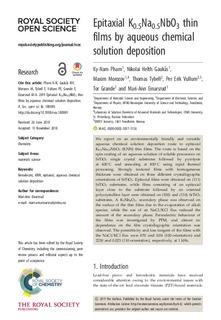| dc.contributor.author | Pham, Ky-Nam | |
| dc.contributor.author | Gaukås, Nikolai Helth | |
| dc.contributor.author | Morozov, Maxim | |
| dc.contributor.author | Tybell, Per Thomas Martin | |
| dc.contributor.author | Vullum, Per Erik | |
| dc.contributor.author | Grande, Tor | |
| dc.contributor.author | Einarsrud, Mari-Ann | |
| dc.date.accessioned | 2019-03-18T12:43:35Z | |
| dc.date.available | 2019-03-18T12:43:35Z | |
| dc.date.created | 2019-01-15T10:36:04Z | |
| dc.date.issued | 2019 | |
| dc.identifier.citation | Royal Society Open Science. 2019, 6 180989-?. | nb_NO |
| dc.identifier.issn | 2054-5703 | |
| dc.identifier.uri | http://hdl.handle.net/11250/2590489 | |
| dc.description.abstract | We report on an environmentally friendly and versatile aqueous chemical solution deposition route to epitaxial K0.5Na0.5NbO3 (KNN) thin films. The route is based on the spin coating of an aqueous solution of soluble precursors on SrTiO3 single crystal substrates followed by pyrolysis at 400°C and annealing at 800°C using rapid thermal processing. Strongly textured films with homogeneous thickness were obtained on three different crystallographic orientations of SrTiO3. Epitaxial films were obtained on (111) SrTiO3 substrates, while films consisting of an epitaxial layer close to the substrate followed by an oriented polycrystalline layer were obtained on (100) and (110) SrTiO3 substrates. A K2Nb4O11 secondary phase was observed on the surface of the thin films due to the evaporation of alkali species, while the use of an NaCl/KCl flux reduced the amount of the secondary phase. Ferroelectric behaviour of the films was investigated by PFM, and almost no dependence on the film crystallographic orientation was observed. The permittivity and loss tangent of the films with the NaCl/KCl flux were 870 and 0.04 (100-orientation) and 2250 and 0.025 (110-orientation), respectively, at 1 kHz. | nb_NO |
| dc.language.iso | eng | nb_NO |
| dc.publisher | The Royal Society | nb_NO |
| dc.rights | Navngivelse 4.0 Internasjonal | * |
| dc.rights.uri | http://creativecommons.org/licenses/by/4.0/deed.no | * |
| dc.title | Epitaxial K0.5Na0.5NbO3 thin films by aqueous chemical solution deposition | nb_NO |
| dc.type | Journal article | nb_NO |
| dc.type | Peer reviewed | nb_NO |
| dc.description.version | publishedVersion | nb_NO |
| dc.source.pagenumber | 180989-? | nb_NO |
| dc.source.volume | 6 | nb_NO |
| dc.source.journal | Royal Society Open Science | nb_NO |
| dc.identifier.doi | http://dx.doi.org/10.1098/rsos.180989 | |
| dc.identifier.cristin | 1656885 | |
| dc.relation.project | Norges forskningsråd: 197497 | nb_NO |
| dc.relation.project | Norges forskningsråd: 250184 | nb_NO |
| dc.relation.project | Norges forskningsråd: 245963 | nb_NO |
| dc.relation.project | Norges forskningsråd: 197405 | nb_NO |
| dc.description.localcode | © 2019 The Authors. Published by the Royal Society under the terms of the Creative Commons Attribution License http://creativecommons.org/licenses/by/4.0/, which permits unrestricted use, provided the original author and source are credited. | nb_NO |
| cristin.unitcode | 194,66,35,0 | |
| cristin.unitcode | 194,63,35,0 | |
| cristin.unitcode | 194,66,20,0 | |
| cristin.unitname | Institutt for materialteknologi | |
| cristin.unitname | Institutt for elektroniske systemer | |
| cristin.unitname | Institutt for fysikk | |
| cristin.ispublished | true | |
| cristin.fulltext | original | |
| cristin.qualitycode | 1 | |

